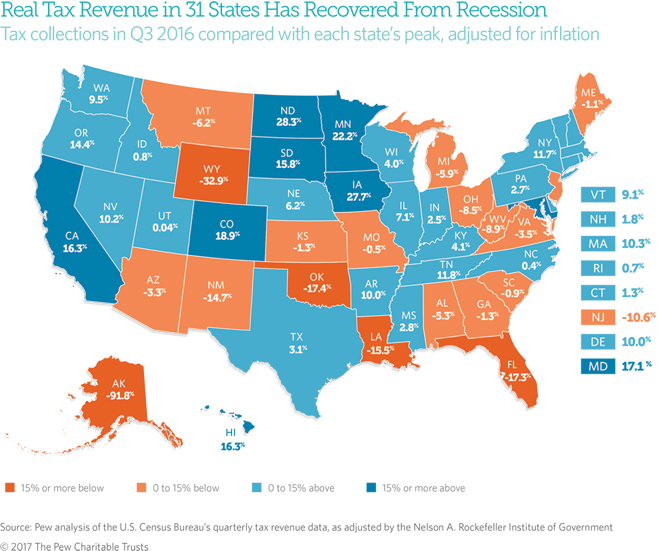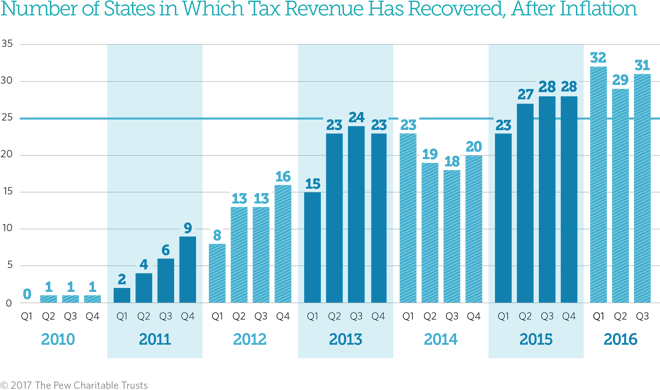Tax Revenue Has Recovered in 31 States, Despite Flat Q3
Note: These data have been updated. To see the most recent data and analysis, visit Fiscal 50
Note: On June 28, 2017, this analysis was updated to reflect corrected data for Oregon from the U.S. Census Bureau. With the revision, the state’s tax revenue in the third quarter of 2016 was 14.4 percent above its 2008 peak, rather than 32.7 percent as previously reported, and growth in 50-state receipts was 5.6 percent, rather than 5.8 percent.
Growth in total state tax revenue stalled in the third quarter of 2016, extending a rare drop in tax collections outside of a recession. Even so, more than seven years after the end of the Great Recession, receipts nationally and in 31 states have risen enough to recover from losses in the downturn, after accounting for inflation.
State tax revenue growth was flat even as the national economy continued to expand. In the third quarter of 2016, collections nationally were 5.6 percent higher than they were before plunging in the first year of the recession, after adjusting for inflation and averaging across four quarters to smooth seasonal fluctuations. But that was down from a post-recession high of 6.7 percent in the first quarter of 2016.
The results mean that the 50 states combined had the equivalent of 5.6 cents more in purchasing power for every $1 they collected at their peak before receipts fell in 2008. But results varied widely from state to state.
In eight of the 31 states in which collections had recovered by the third quarter of 2016, tax revenue—and thus purchasing power—was more than 15 percent higher than at its peak before or during the recession. Conversely, collections were down 15 percent or more in five of the 19 states in which tax revenue was still below peak.
Overall, state tax revenue has bounced back more slowly after the 2007-09 recession than the three previous downturns, but drops in total collections are rare. Besides the mid-2016 decline, collections have fallen only one other time since the recession ended: in the first half of 2014, after taxpayers shifted income in response to federal tax changes.
Although total tax revenue held steady, collections in the third quarter of 2016 fell in 21 states. Eight have had declines for at least a full year. Low energy prices, weak consumer spending, and the slowest growth in state personal income in three years helped drive down revenue in mid-2016. Tax cuts contributed to drops in Illinois, North Dakota, and Ohio, and in a few states, receipts showed declines because they grew more slowly than inflation.
Such revenue trends have led to budget pressures in a number of states. Even if revenue increases, states may face higher expenditures due to population growth, changes in Medicaid costs and enrollment, and deferred or new needs for schools, safety-net programs, corrections, employee salaries and pensions, and road maintenance and construction.
Projected growth for the fourth quarter of 2016 was exceedingly sluggish, raising prospects that certain states could face budget gaps before the end of fiscal year 2017. According to preliminary figures from the Nelson A. Rockefeller Institute of Government, state tax collections in 2016’s fourth quarter rose just a fraction of a percent, with particularly lackluster growth in personal income taxes. In addition to economic factors, state tax revenue may have been affected by the possibility of federal tax cuts or other tax policy changes with the election of President Donald Trump, leading some taxpayers—especially high-income earners—to delay income or accelerate deductions to try to lower their tax liabilities.
State highlights
A comparison of each state’s tax receipts in the third quarter of 2016 with its peak quarter of revenue before the end of the recession, averaged across four quarters and adjusted for inflation, shows:
- Eight states posted tax revenue rebounds of 15 percent or more: North Dakota (28.3 percent), Iowa (27.7 percent), Minnesota (22.2 percent), Colorado (18.9 percent), Maryland (17.1 percent), Hawaii (16.3 percent), California (16.3 percent), and South Dakota (15.8 percent).
- North Dakota remained the leader among all states in tax revenue growth since the recession, although its collections have dropped dramatically since the 2014 plunge in oil prices. At the end of that year, receipts hit a high of 124.5 percent above their peak during the recession, compared with 28.3 percent above in the third quarter of 2016. Besides the decline in oil-related tax dollars, an income tax cut enacted in 2015 also reduced revenue.
- Alaska (-91.8 percent) was furthest below its peak. The state collected only about 8 percent as much in inflation-adjusted tax dollars as it did at its short-lived peak in 2008, when a new state oil tax coincided with record-high crude prices. Without personal income or general sales taxes, Alaska is highly dependent on oil-related severance tax revenue, which began falling even before worldwide crude prices declined in 2014 as its oil production waned.
- Four additional states were down more than 15 percent from their previous peaks: Florida (-17.3 percent), Louisiana (-15.5 percent), Oklahoma (-17.4 percent), and Wyoming (-32.9 percent).
- Two states hit a new low in tax collections since the recession amid weakness in coal, oil, and natural gas industries: Wyoming (-32.9 percent) and West Virginia (-8.9 percent).
- The eight states that had at least a full year of declining tax revenue were Illinois and energy-reliant Colorado, New Mexico, North Dakota, Oklahoma, Texas, West Virginia, and Wyoming. The lengthiest slide—of eight straight quarters—has been in Illinois, where a temporary personal income tax hike expired in January 2015 and revenue and spending decisions are mired in an extended budget impasse.
- Three states moved onto the list of states whose tax revenue had recovered: Idaho (0.8 percent), North Carolina (0.4 percent), and Utah (0.04 percent). Newly revised data show that Utah’s tax revenue regained its pre-recession level in the first quarter of 2016.
Trends over time
The number of states that have shaken off the effects of the Great Recession and regained their tax revenue levels has risen and fallen, reflecting increased volatility in state tax collections.
In 2010, North Dakota was the first state to surpass its recession-era peak, followed by Vermont, then Arkansas and New York by mid-2011. Tax receipts were above peak in nine states at the end of calendar 2011; 16 states at the end of 2012; 23 states at the end of 2013; 20 states at the end of 2014; and 28 states at the end of 2015.
State results differ dramatically because of variations in economic conditions, population changes, and tax policy choices since the recession. Among states in which tax revenue has recovered, some, such as Nevada and Washington, have raised taxes since the recession, contributing to gains. Among states in which receipts remain below their previous peaks, some, such as Florida and Ohio, chose to cut taxes since the recession.
State budgets do not adjust revenue for inflation, so tax revenue totals in states’ own documents will appear higher than or closer to pre-recession totals. Without adjusting for inflation, 50-state tax revenue was 18.7 percent above peak and tax collections had recovered in 44 states—all except Alaska, Florida, Louisiana, New Mexico, Oklahoma, and Wyoming—as of the third quarter of 2016. Unadjusted figures do not take into account changes in the price of goods and services.
Adjusting for inflation is just one way to evaluate state tax revenue growth. Different insights would be gained by tracking revenue relative to population growth or state economic output.
Download the data to see individual state trends from the first quarter of 2006 to the third quarter of 2016. Visit The Pew Charitable Trusts’ interactive resource Fiscal 50: State Trends and Analysis to sort and analyze data for other indicators of state fiscal health.










